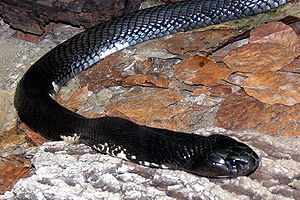- Naja siamensis
-
Indo-Chinese Spitting Cobra 
Scientific classification Kingdom: Animalia Phylum: Chordata Subphylum: Vertebrata Class: Reptilia Order: Squamata Suborder: Serpentes Family: Elapidae Genus: Naja Species: N. siamensis Binomial name Naja siamensis
Laurenti, 1768Naja siamensis or the Indo-Chinese Cobra is a species of spitting cobra found in Southeast Asia. It is one of the six spitting cobras found in Asia.
Contents
Description
This is a medium-sized cobra with a rather thick body. The body color of this species is variable from grey to brown to black, with white spots or stripes. The white patterning can be so prolific that it covers the majority of the snake. Adults average 90–120 cm (3–4 ft) in length, and can reach a maximum of 1.6 metres (5 ft).
This species should not be confused with Naja kaouthia, the Monocled cobra, which has similar habitat, size and appearance.
Distribution and habitat
It is found in Southeast Asia, including Thailand, Cambodia, Vietnam, Laos and Burma. It occupies a range of habitats including lowlands, hills, plains, and woodland. It is sometimes attracted to human settlements because of the abundant populations of rodents in and around these areas.
Behavior
It is a primarily nocturnal species.[citation needed] Interestingly, it shows variable temperament depending on the time of day it is encountered. When threatened during daylight hours, the snake is generally timid and seeks refuge in the nearest burrow. However, when the snake is threatened at night, it is more aggressive and is more likely to stand its ground, rear up and display its hood.
This cobra is capable of spraying venom up to 3 metres (10 ft). It usually aims for the intruder's head.
Diet
It usually feeds on rodents, birds, and small reptiles.
Venom
Like most elapids, its venom is primarily neurotoxic. Bite symptoms include pain, swelling and necrosis around the wound. The bite of this snake is potentially lethal to an adult human. Deaths, which generally happen due to paralysis and consequent asphyxiation, mainly occur in rural areas where the procurement of antivenin is difficult.
If the snake spits venom into the eyes of an individual, he/she will experience immediate and severe pain as well as temporary and sometimes even permanent blindness.
Reproduction
The snake is oviparous. The female will lay 13-28 eggs 100 days after oviposition. Eggs will hatch after 48 to 70 days depending on the temperature of incubation. Offspring are independent as soon as they have hatched. Hatchlings are 12–20 cm in length and, because they possess fully developed venom delivery systems, should be treated with the same respect as adults.
References
- Mark O'Shea, Tim Halliday, Reptiles and amphibians (ISBN 957-469-519-0)
- Living hazards - Snakes
Categories:- Elapidae
- Reptiles of Asia
Wikimedia Foundation. 2010.
